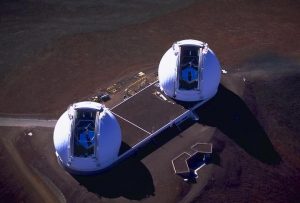
The theoretical limitation on the resolving power of a telescope depends on the diameter of its primary mirror or lens. The larger the diameter, the higher the resolution it should be able to achieve, assuming it doesn’t suffer from any defects. However, in practice, the resolution achievable by the largest ground-based telescopes is limited by disturbances in the Earth‘s atmosphere, which refracts and distorts the light passing through it. This atmospheric distortion is the reason that stars appear to twinkle in the night sky.
In order to reduce the effects of atmospheric distortion, large telescopes are often built at high altitudes on top of mountains – such as the famous Keck telescopes on Mauna Kea in Hawaii – where the atmosphere above is much thinner, and often stiller than at lower altitudes. Each of the two Keck telescopes use 10-metre primary mirrors.
An alternative approach is to build telescopes on aircraft flying at high altitude, or place telescopes in space, such as the Hubble Space Telescope (HST). However, the larger the telescope, the more expensive it would be to launch it into orbit. The HST has a relatively small 2.4-metre primary mirror, in comparison to the largest ground-based telescopes of over 10 metres, yet its view of the universe, unobstructed by the Earth’s atmosphere, makes it one of the most powerful telescopes we have at our disposal.
Adaptive optics
Modern large telescopes can have primary mirrors that are several metres in diameter. They are often built in hexagonal or circular segments, which fit together when assembled. Each mirror segment is not ridged, like a traditional telescope’s mirror, but is made from a thin flexible material. The segments are mounted on a system of computer-controlled hydraulic rams, which continuously manipulate the precise shape of the mirror in order to compensate for the effects of atmospheric distortion. This is known as “adaptive optics”.
The computer can determine the precise shape that the mirror needs to be, by comparing the wavefront of the light received from a bright star with the ideal shape that the wavefront would be expected to have without the effects of atmospheric distortion.
However, there will not always be a suitable large, bright “guide” star in the narrow field of view of the telescope. To get around this problem, a laser beam is fired into the sky in the direction that the telescope is pointing. This laser beam is scattered by ice crystals high in the atmosphere, creating an artificial “guide star”, which can be used to calibrate the shape of the telescope’s mirror.
Adaptive optics is able to produce much clearer images than traditional large, ground-based telescopes with ridged mirrors of the same size, allowing them to achieve something closer to the theoretical limitation of their resolving power.
Interferometry
The technique of Interferometry can be used to link two or more widely separated telescopes to create a ‘synthetic aperture’. This gives the combined system of telescopes the same resolving power that a telescope with a primary mirror (i.e. aperture) of a diameter equal to the distance between the telescopes would have.
It would be possible, for example, to place two telescopes in equivalent orbits on opposite sides of the Earth and link them together to create a synthetic aperture with a resolving power equivalent to a giant telescope with a diameter wider than the Earth. Then again, it would also be possible to place two or more telescope in orbit around the Sun to create a telescope with an synthetic aperture that could be wider than the diameter of the Earth’s orbit.
However, even though interferometry can be used to increase resolution, the brightness of the image will still be dependent on the combined physical area of the linked telescope’s light-gathering surfaces.
Interferometry is technically challenging as the images from the separate telescopes must be combined with precise timing. However, the longer the wavelength of the electromagnetic radiation, the less precise the timing needs to be, which is why interferometry is often used to link arrays of multiple radio telescopes. Interferometry has been successfully used at optical wavelength, however, to link the two large Keck telescopes on Mauna Kea in Hawaii. Both these telescopes have primary mirrors of 10 meters in diameter, but linking them together through interferometry creates a synthetic aperture equivalent in size to an 85 metre diameter mirror. Despite adaptive optics, however, the effect of atmospheric turbulence still limits the effective resolution that can be achieved by the combined Keck telescopes.